Incheon Subway Line 1
| Incheon Line 1 | |
|---|---|
 | |
| Overview | |
| Native name |
인천 1호선(仁川一號線) Incheon Il Hoseon |
| Type | Rapid transit |
| System | Incheon Subway |
| Status | Operational |
| Termini |
Gyeyang International Business District |
| Stations | 29 |
| Operation | |
| Opened | October 6, 1999[1] |
| Operator(s) | Incheon Transit Corporation |
| Technical | |
| Line length | 29.4 km (18.3 mi)[2] |
| Number of tracks | 2 |
Incheon Subway Line 1 is a 29.4-kilometer (18.3 mi) north-south subway line,[2] part of the Incheon Subway system. The line is also included as a part of the overall Seoul Metropolitan Subway network; Bupyeong Station has a free transfer with Seoul Subway Line 1, Gyeyang Station connects with the AREX Line which leads to Incheon International Airport and Seoul Station, Bupyeong-gu Office Station has a free transfer with Seoul Subway Line 7, and Woninjae Station has a free transfer with the Suin Line.
Background
Incheon's Line 1 makes Incheon the fourth city in Korea with a subway system in South Korea, after Seoul, Busan, and Daegu.
A trip along the line from Gyeyang in the north to Int'l Business District in the south takes approximately 57 minutes. From Bakchon station to International Business District station, the line is underground.
History
- March 1999: Trial runs begin.
- October 6, 1999: The line opens from Bakchon to Dongmak, after six years of construction.
- December 7, 1999: A northern extension from Bakchon to Gyulhyeon opens.
- March 16, 2007: Another northern extension from Gyulhyeon to Gyeyang opens, connecting with the Airport Railroad
- June 1, 2009: A southern extension from Dongmak to International Business District opens.
Future plans
Another southward extension of the line is proposed to provide transportation to Songdo Landmark City. The extension will be 0.84 kilometers (0.52 mi) long and is planned to open in 2018.[3]
Another northward extension of the line is proposed to provide transportation to the developing Geomdan New City. No opening time has been announced.
Rolling Stock
The line uses 34 8-car trains. The first 25 trains were built between 1998 and 1999 by Daewoo Heavy Industries and Rotem, while the last 9 trains were built between 2007 and 2008 by Hyundai Rotem to provide trains following the extension of the line.
Stations
| Number |
English |
Hangul |
Hanja |
|
|
in km |
Distance |
| |
| |
Gyeyang | 계양 | 桂陽 | |
|
|
|
|
|
| |
Gyulhyeon | 귤현 | 橘峴 | |
| ||||
| |
Bakchon | 박촌 | 朴村 | |
| ||||
| |
Imhak | 임학 | 林鶴 | |
| ||||
| |
Gyesan | 계산 | 桂山 | |
| ||||
| |
Gyeongin National University of Education | 경인교대입구 | 京仁敎大入口 | |
| ||||
| |
Jakjeon | 작전 | 鵲田 | |
| ||||
| |
Galsan | 갈산 | 葛山 | |
|
| |||
| |
Bupyeong-gu Office | 부평구청 | 富平區廳 | |
|
| |||
| |
Bupyeong Market | 부평시장 | 富平市場 | |
| ||||
| |
Bupyeong | 부평 | 富平 | Seoul 1 | |
| |||
| |
Dongsu | 동수 | 東樹 | |
| ||||
| |
Bupyeongsamgeori | 부평삼거리 | 富平삼거리 | |
| ||||
| |
Ganseogogeori | 간석오거리 | 間石오거리 | |
|
| |||
| |
Incheon City Hall | 인천시청역 | 仁川市廳 | 2 | |
| |||
| |
Arts Center | 예술회관 | 藝術會館 | |
| ||||
| |
Incheon Bus Terminal | 인천터미널 | 仁川터미널 | |
|
| |||
| |
Munhak Sports Complex | 문학경기장 | 文鶴競技場 | |
|
| |||
| |
Seonhak | 선학 | 仙鶴 | |
| ||||
| |
Sinyeonsu | 신연수 | 新延壽 | |
| ||||
| |
Woninjae | 원인재 | 源仁齋 | Suin | |
| |||
| |
Dongchun | 동춘 | 東春 | |
| ||||
| |
Dongmak | 동막 | 東幕 | |
| ||||
| |
Campus Town | 캠퍼스타운 | 캠퍼스타운 | |
| ||||
| |
Technopark | 테크노파크 | 테크노파크 | |
| ||||
| |
BIT Zone | 지식정보단지 | 知識情報團地 | |
| ||||
| |
University of Incheon | 인천대입구 | 仁川大入口 | |
| ||||
| |
Central Park | 센트럴파크 | 中央公園 | |
| ||||
| |
International Business District | 국제업무지구 | 國際業務地區 | |
| ||||
See also
References
| Wikimedia Commons has media related to Incheon Metro Line 1. |